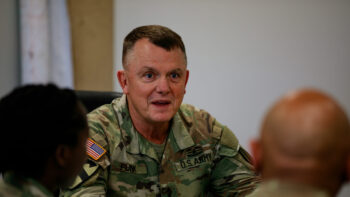
Seen through a rearview mirror mounted on a tree, Ukrainian Army soldiers man a frontline position on May 20, 2022 in Kharkiv Oblast, Ukraine. (Photo by John Moore/Getty Images)
ARLINGTON, Va.: The US Army’s forthcoming multi-domain operations doctrine, previously expected to be published in June, will come out later than expected as the Army evaluates it against the unfolding war in Ukraine, according to a top general, including dispatching a team to Europe to glean the latest information.
The Russian invasion of Ukraine has given the Army a chance to ensure that its multi-domain operations concept, essentially how the Army plans to fight wars in the future, is adequately developed and effective, said Gen. Paul Funk, commander of Army Training and Doctrine Command (TRADOC).
“Somebody has presented us an opportunity to look at our stuff and not expose our most precious treasure — our sons and daughters — to it,” Funk told reporters Thursday after an event hosted by the Association of the US Army. “And they’ve given us this opportunity to look at it. Why would we not take advantage of that just for some timeline? Why would we not look at this and make sure we’re we’re on the right track?”
RELATED: US to provide 4 HIMARS systems to Ukraine in latest $700M arms package
The delay could be news to lawmakers who were told just last month by Army Chief of Staff Gen. James McConville that June was still the target deadline for the doctrine. Spokespeople for neither the Army nor TRADOC clarified the apparent disparate timelines as of press time following a request from Breaking Defense Thursday.

Gen. Paul Funk, commander of the Army’s Training and Doctrine Command (TRADOC), at Fort Hood, Texas July 15, 2021. (Staff Sgt. Daniel Herman/US Army)
The Army has been developing its multi-domain operations strategy as the service’s future warfighting concept for several years. It’s meant to establish how the service plans to fight on the future battlefield in all the warfighting domains, including digital and electronic operations. But in light of Russia’s invasion of Ukraine, the Army has an opportunity to measure its draft doctrine against a real-world conflict.
Funk said the doctrine still will be out before the end of the calendar year and that Army is taking an extra “90 to 100 days” to “look at it to make sure we’re on track.”
“I think we are,” Funk said. “Frankly, it’s been pretty clear that we are.”
Funk said that the service had sent personnel from the Army’s Center for Lessons Learned and doctrine staff to Europe to “capture and check what we’re writing as doctrine.” The goal is make sure what is written in doctrine is what war is “going to look like on the battlefield of today and is it going to be sufficient for tomorrow,” he said.
The four-star declined to say exactly where the doctrine and lessons learned staff are in Europe. But, he said, they are talking to Ukrainians, people training Ukrainians and refugees to gather as much information as possible about the Russian military from the tactical level up to the strategic.
“They’re trying to gather on everything, but they’re trying to do it through a lens of ‘Are we going to be ready for the future?’,” Funk said.
Russia’ unprovoked invasion of Ukraine began in late February. Though they’ve been beaten back by a surprisingly aggressive Ukrainian resistance, the Russian military has used artillery to devastating effect, pummeling several Ukrainian cities and, the United Nations says, killing thousands of civilians. But the war has come at tremendous cost for the Russians, with thousands of troops killed, according to NATO. Russia has also reportedly lost hundreds, if not thousands, of ground vehicles in Ukraine. The war has highlighted numerous shortfalls of the Russian military has it tries to move troops and supplies around the battlefield, providing myriad lessons for the US military.
Earlier this week, Army Secretary Christine Wormuth said, for instance, that the conflict had demonstrated the importance of logistics, the impact that drones can have on the battlefield and the necessity of secure communications.
“We are very much looking every single day in real-time at what’s happening in Ukraine,” Wormuth said.
The Army’s broader multi-domain operations effort includes new formations and new platforms. The Army is in the midst of a multi-billion dollar modernization effort that includes new, secure networks to longer-range artillery and advanced helicopters — all with an eye on potential conflict with Russia and China.
The Army’s also created Multi-Domain Task Forces in the Indo-Pacific and Europe that will be home to long-range fires, cyber and electronic warfare capabilities as part of multidomain operations.
“This is a doctrine for 2030,” Funk said. “So let’s make sure it’s at least as right as we can make it right now.”






















